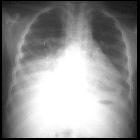Osteomyelofibrose






































Primary myelofibrosis is a myeloproliferative neoplasm in which there is the replacement of bone marrow with collagenous connective tissue and progressive fibrosis. It is characterized by:
- extramedullary hematopoiesis
- progressive splenomegaly
- anemia
- variable change in the number of granulocytes and platelets including thrombocytopenia
Epidemiology
It usually affects the middle-aged to elderly, with a mean age of 60 years. The estimated prevalence is ~1:100,000.
Pathology
It is considered a chronic BCR-ABL1 (breakpoint cluster region-Abelson murine leukemia viral oncogene homologue 1)-negative myeloproliferative disorder .
Non-neoplastic fibroblasts produce collagen, which replaces normal bone marrow elements. This bone marrow fibrosis is a result of an inappropriate release of PDGF and TGF-ß from neoplastic megakaryocytes .
Radiographic features
Most radiological features are a result of extramedullary hematopoiesis and seen in many systems.
General
Musculoskeletal
Abdominal
- hepatomegaly
- splenomegaly: can be massive
- some patients may also experience splenic infarcts
- evidence of portal hypertension
- from increased splenic blood flow
- from portal flow obstruction from the sinusoidal hematopoietic proliferation
Cardiovascular
- may show evidence of congestive cardiac failure due to anemia
Treatment and prognosis
Prognosis is poor, with slow progression and death usually within 2-3 years. It can also transform into acute myeloid leukemia in a small number of patients .
Complications
- gout: from hyperuricemia due to increased hematopoietic turnover
- splenic rupture (rare)
- bleeding from thrombocytopenia (see case 8)
Differential diagnosis
General differential considerations include:
- for musculoskeletal manifestations: consider the differential diagnosis of diffuse bony sclerosis
- for splenic manifestations: consider differential diagnosis for splenomegaly
See also
Siehe auch:
- Splenomegalie
- Sichelzellenanämie
- Thalassämie
- Tumoren des hinteren Mediastinums
- Bürstenschädel
- diffuse skelettale Sklerosierung
- paraspinal mass
- Hereditäre Sphärozytose
- thoracic paraspinal mass
und weiter:
- diffus hypointenses Knochenmarksignal in T1
- diffuse bony sclerosis (mnemonic)
- Superscan Szintigraphie
- extramedulläre Hämatopoese
- Knochenmarksveränderungen im MRT
- Knochentumoren
- Knochenmark
- Knochenmarksveränderungen nach Bestrahlung
- secondary gout
- secondary gout in primary myelofibrosis
- Myeloproliferative Neoplasien (MPN)

 Assoziationen und Differentialdiagnosen zu Osteomyelofibrose:
Assoziationen und Differentialdiagnosen zu Osteomyelofibrose:






